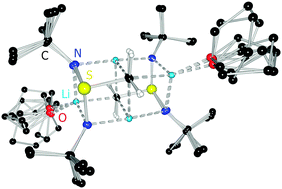Isovalent electronic replacement of the oxygen atoms in the classic SOnm− molecules and ions by NR imido groups yields the polyimido sulfur species S(NR)nm−, n = 2, 3, 4 and m = 0, 2. The crucial cornerstone to the richness of SN chemistry is the access to sulfur diimides S(NR)2 and triimides S(NR)3. While the syntheses of the first are well established the preparations of the second were hazardous and of poor yields. A new facile, safe and elaborated route to give quantitative yields is presented. It involves the synthesis of triimido sulfites S(NR)32−, which are versatile ligands in their own right. With a trigonal pyramidal shape, containing three basal negatively charged nitrogen atoms, they are rare examples of dianionic tripodal ligands. Various (mixed) metal complexes are presented. Lithium coordination at the N–S–N bisections converts the dianion into the inverse tripod ligand Li3(NR)3S+, capable of anion solvation. Among others, this motif stabilizes unprecedented monomeric methyllithium and lithium enolate. In the reaction of sulfur diimides S(NR)2 and triimides S(NR)3 with organometallics the diimidosulfinates RS(NR)2− and triimidosulfonates RS(NR)3− are synthesised. Both display a rich coordination chemistry to various metals, which is discussed in the review. Furthermore, the S-organo substituent can be modified in various ways. It can be a linker between two SN moieties or can be shaped to a R2N- or R2P-donating side arm of any form or length to give hemilabile scorpionates. Their ample application in metal coordination and anion solvation is presented. These monoanions can be converted to the related ylides by deprotonation of the S-alkyl group. The diimidosulfur(IV) ylides (R2C)S(NR)22− and triimidosulfur(VI) ylides (R2C)S(NR)32− contain the CR2 methylene group, isoelectronic to the NR imido group. Their coordination behaviour and reactivity are discussed. In addition to the rich SN chemistry the S–N and S–C bonding is elucidated by means of theoretical and experimental charge density investigations and topological analyses on the basis of multipole refinement. As the most important result hypervalency at sulfur and S![[double bond, length as m-dash]](https://www.rsc.org/images/entities/char_e001.gif) N(C) double bonding are ruled out as superfluous concepts.
N(C) double bonding are ruled out as superfluous concepts.

You have access to this article
 Please wait while we load your content...
Something went wrong. Try again?
Please wait while we load your content...
Something went wrong. Try again?
![[double bond, length as m-dash]](https://www.rsc.org/images/entities/char_e001.gif) N(C) double bonding are ruled out as superfluous concepts.
N(C) double bonding are ruled out as superfluous concepts.

 Please wait while we load your content...
Please wait while we load your content...